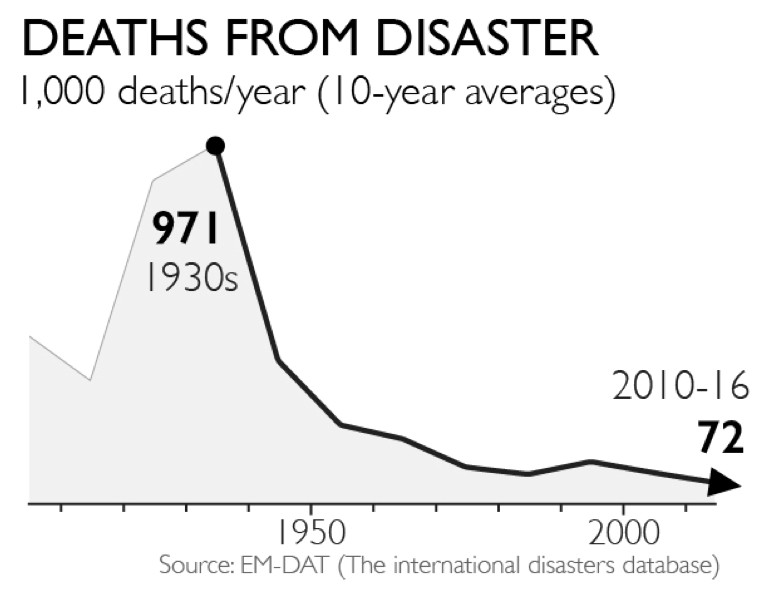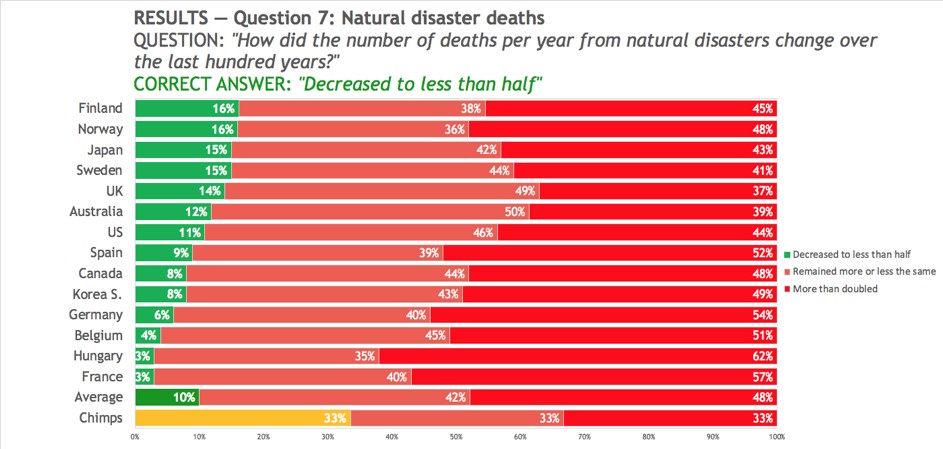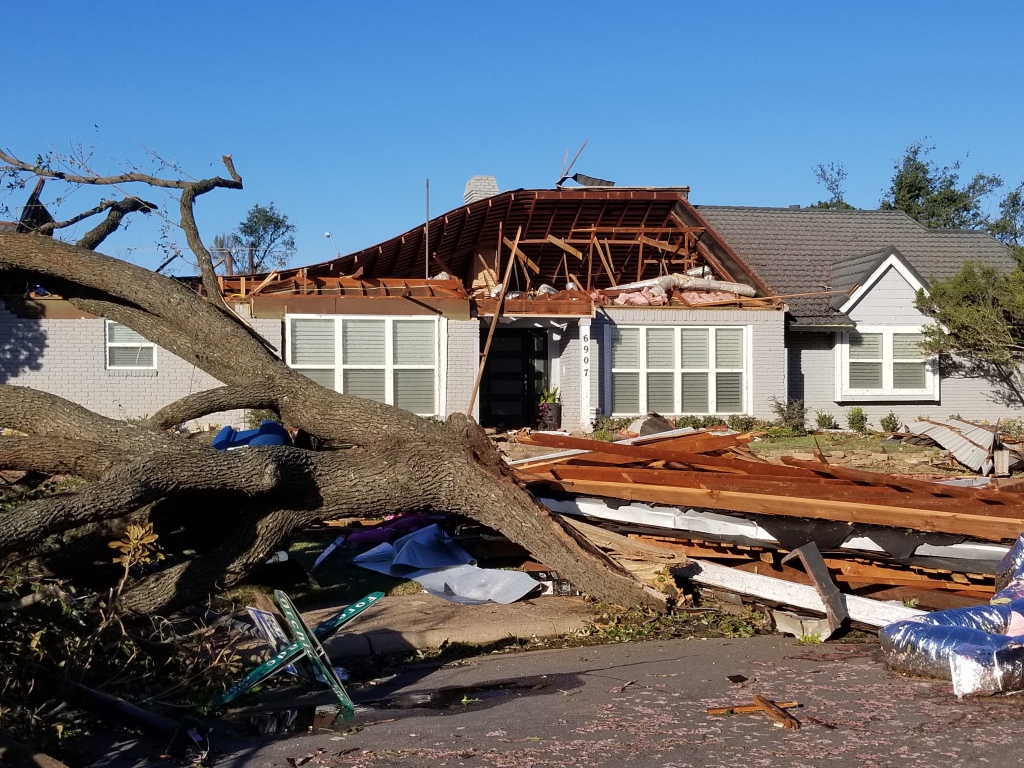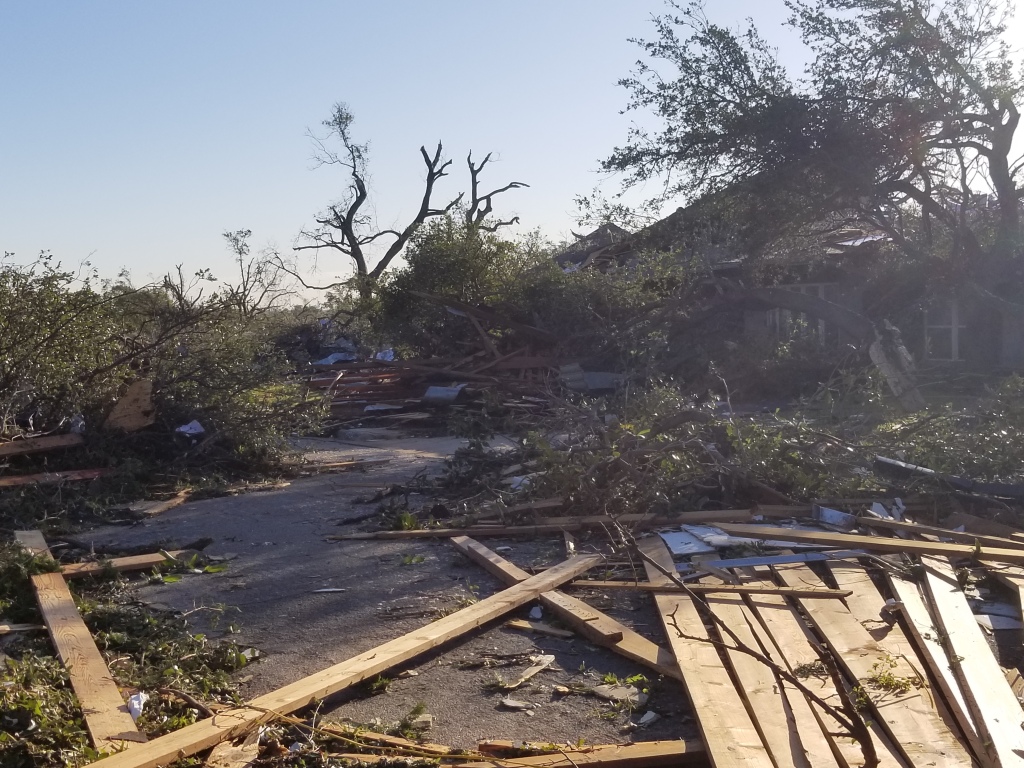Super fact 35: Natural disasters kill a lot less people now compared to 100 years ago. That is despite a larger population and despite the fact that climate change has increased the frequency and intensity of many types of natural disasters.
This is a super fact because surveys, such as this questionnaire from Gap Minder, show that the vast majority of the public (90%) believe that deaths from natural disasters have increased or stayed the same. Gap Minder is a Swedish highly respected non-profit founded by Hans Rosling that promotes increased use and understanding of statistics. Our World in Data (OWID), a renowned scientific online publication focusing on large global problems largely took its inspiration for Gap Minder and Hans Rosling.
The reason for the fewer deaths from natural disasters is not that there are fewer natural disasters, on the contrary, it is because we are now much better at predicting, handling and recovering from natural disasters. Our warnings systems, rescue systems and healthcare have improved significantly.
The graphics in this article from BBC show that the frequency of natural disasters has increased, and that the cost of natural disasters has increased, and yet the number of deaths has decreased.
The graph below comes from the Gap Minder article. It shows the annual deaths from natural disasters in ten-year intervals starting with 1930. In the 1930’s there were 971 thousand deaths per year from natural disasters and during the period 2010 to 2016 there were 72 thousand deaths per year from natural disasters, an improvement by more than 13 times.
However, it should be noted that there was a huge flood in China 1931 causing an estimated 3 million deaths, and it skews the numbers for the 1930’s interval.
Originally, I set the headline for this super fact to be “10 Times more people died from natural disasters a hundred years ago” but I changed it to “Natural Disasters Kill Less People Now Than 100 Years Ago” because I realized that the 1930’s peak is an outlier because of the 1931 flood. I don’t want my headlines to be click bait.

This does not mean that we should not worry about the increase in frequency and intensity of natural disasters from climate change. First of all, there are no warning systems and healthcare available for Koalas and Elephants, secondly cost matters, and thirdly there is no guarantee that we can keep improving our ability of predicting, handling and recovering from natural disasters enough to match the accelerating risks for natural disasters.
What People Believe Regarding Disaster Deaths
The Gap Minder article above report on a question survey conducted by Gap Minder. They asked large groups of people in 14 countries the following multiple-choice question “How did the number of deaths per year from natural disasters change over the last hundred years?” The choices were:
- A. More than doubled
- B. Remained more or less the same
- C. Decreased to less than half
Most people answered A, a lot
of people answered B, but only 10% got the correct answer C, decreased to less than half. In other words, if chimpanzees had answered this question by randomly picking an answer, they would have done better than people. This is why I consider this a super fact. Below is a graphics taken from the Gap Minder article that shows how people in different countries responded.

EF3 Tornado in Dallas
In October 2019 an EF3 tornado ripped through our neighborhood. It left a 2-3 miles long trail of destruction. Roofs were lifted off houses, cars and buses were flown around, hundreds of houses were destroyed, bricks were flying around in the wind, trees were uprooted, and tree branches were flying around, and pieces of concrete crashed into buildings and hit steel fences so forcefully that it bent even quarter inch thick steel fences.
Unlike many of our neighbor’s houses, our house stood, but our chimney was smashed by a piece of concrete coming off a neighbor’s house, we had to replace our roof, our garage door, the wiring in the attic, our fence and my grill flew around in the yard. The amazing thing was that no one in the neighborhood died.
Why did no one die? Was it maybe because no one was outside walking the dog, or driving around, because everyone had received the alarm on their mobile phone about the approaching tornado and was therefore sheltering inside in a safe place? Imagine the same thing happening in the 1930’s.
Below are a few photos from that day and here are two links with more photos, link-1 , link-2. On the five-year anniversary of this event NBC news interviewed me about this event. To see the interview click here . My interview is at one minute and ten seconds.



My wife Claudia asked me to go check on her parents. I drove about 50-100 yards when a neighbor’s roof lying across the road stopped me. I turned around but this time I was stopped by a large pile of trees lying across the street. So, I started walking, but this time I was stopped by a group of firemen telling me that it was too dangerous to be outside. They told me to go back home, and I did. The next day we were able to visit her parents and below is what we saw.



I can see why so many would think there were more disaster deaths, because there are more fires and floods now. But thinking about it, despite some very bad wildfire years in British Columbia and Alberta in the last 10 years, there have been few deaths. There were terrible floods in southern BC in 2021 that killed a lot of livestock, but not many people. The only recent deadly fire I can think of was the one in Lahaina, Hawaii, but the destructive fires recently in the Los Angeles area did not cause the same number of human deaths.
Thanks for the links to Gap Minder and the World in Data.
LikeLiked by 2 people
Yes you are right. It is easy to believe there are more disaster deaths. But more natural disasters doesn’t necessarily mean more deaths. We have gotten so much better at preventing deaths, and that is something people forget. It is true for so many other topics too. We have a negativity bias that makes us forget what we’ve gotten better at. With recent pandemics, easy travel, more people, etc., it is easy to believe that infectious disease must have gotten worse, but we forget about vaccines and much better healthcare taking the trend in the opposite direction, despite those other factors. Thank you so much Audrey.
LikeLiked by 1 person
I wonder why so many people still believe that natural disasters harm so many humans. If it’s lack of general statistics like you exemplified here or a global tendency towards pesimism.
LikeLiked by 2 people
Hans Rosling, the founder of Gap Minder, speaks about a negativity bias. We tend to focus more on bad news. We forget human progress. We may think about climate change making certain natural disasters such as floods, hurricanes, drought and wildfires worse, and we may think about volcanic eruptions, tsunamis and earthquakes, even though not more common, they are effecting more people, since there are more people now, and we conclude more people must be killed before considering how much we’ve improved modern life saving measures. Communication, prediction systems, healthcare, rescue systems, all that makes a huge difference.
LikeLiked by 1 person
I’m glad there isn’t as many disaster deaths, but those photos from the tornado are still so so horrifying 😱 sorry again you had to deal with that, Thomas.
LikeLiked by 2 people
Yes the entire neighborhood looked awful afterwards. Total destruction! However, I think the warnings we got on our phones made a big difference. Everyone, was inside even me. I was enjoying a beer in the garden. I knew about the tornado warning, I heard the sirens, the alarm on my phone kept going off. With all that nagging I finally went inside. A couple of minutes later the house shook, the chimney exploded, it was raining bricks, but I was safely inside.
LikeLiked by 1 person
Thankfully 🙏 that’s very important yes.
LikeLiked by 1 person
The warning made all difference. Thank you so much Laura.
LikeLiked by 1 person
The way that the one house was just gone.
LikeLiked by 2 people
Yes the destruction was total. Hundreds of destroyed houses, thousands of damaged houses, lots of debris all over the neighborhoods for miles, but everyone made it out pretty fine. No deaths, no known serious injuries. Well my father in law was injured.
LikeLiked by 1 person
I’m glad no one was killed! That is too bad about your father in law.
LikeLiked by 1 person
Thank you Sara. I think he might have been the only one injured.
LikeLiked by 1 person
An eye-opening statistic, Thomas, and I appreciate the knowledge to increase safety.
LikeLiked by 2 people
Thank you so much Grant. Yes we’ve gotten much better at protecting ourselves. Listening to the cell phone alerts can really make a difference.
LikeLiked by 1 person
The increase in natural disasters is frightening because of the huge costs involved with repairing all the damage. The people survive but they have to rebuild from scratch.
LikeLiked by 2 people
Yes you are right. We have become very effective in regards to preventing deaths but there is not much you can do about the infrastructure (and nature), which is why the cost of natural disasters keeps going up, and insurance premiums with it. Here in Dallas the average home insurance premium has gone up by 42% over the last five years.
LikeLike
That is a lot. Our insurance has gone up to because of all the hail damage and flooding.
LikeLiked by 1 person
We’ve had to replace our roof because hail damage twice, and major repairs on cars from hail damage twice, not to mention replacing the roof, rebuild the chimney, new wiring, new grill, new fence and new garage door because of the tornado. I wonder if our insurance is getting sick of us.
LikeLike
I am sure the insurance is sick of the increased natural disasters. Not your fault, you are a believer in global warming – smile!
LikeLiked by 1 person
The very thought that the agencies that provide the warning are in danger of being neutered by DOGE makes me sick to my stomach. Will you a few years from now have to write a detraction?
LikeLiked by 2 people
Yes that will not help. I hope I will not have to write a a detraction. The thing is that even if the US agencies that provide rescue and aid during natural disasters at home and abroad are scaled down the similar agencies in the rest of the developed world will not. There may be an uptick in deaths but not a reversal. Well, I am speculating. It is difficult to predict the future.
LikeLiked by 1 person
Interesting. With 24/7 news, I think we realise that they are more frequent, and with that I would have expected more deaths. Those warning systems are so important. By the way, you left us hanging (or maybe I missed it), were your in-laws okay? Maggie
LikeLiked by 2 people
Yes the increased frequency of natural disasters as well as the larger population I think is what makes people think that deaths must have gone up. It easy to forget how huge the progress in communication, technology, and healthcare has been and how that helps in natural disasters. About my in-laws. My father in-law was injured but it was not bad. Otherwise they were fine. There house was no longer livable but they rebuilt and while doing that lived in an apartment. The insurance paid for it all. Some people had insurance issues and had trouble but not us.
LikeLiked by 1 person
“if chimpanzees had answered this question by randomly picking an answer, they would have done better than people. ” Oh, dear. That’s pretty damning. I guess there’s a feeling of it’s all going to hell in a handbasket.
LikeLiked by 2 people
Well I guess that’s what I am looking for. Facts that are known to be true, are important – not trivia, but that people quite often get wrong. But I guess that’s what biases will do to you. You get it more often wrong than if you pick randomly.
LikeLiked by 1 person
Yes, I can see that. In this case, people probably see thing getting worse, without realizing the protections people have developed over the years. Storms can and still kill people, but we have warning and technology we didn’t have even fifty years ago.
LikeLiked by 1 person
Yes I believe you are right. I’ve encountered the opposite too, people encountering this statistics and therefore having a hard time believing natural disasters being more frequent and more costly. That was specifically a very conservative but smart guy who distrusted mainstream media. It seems counter intuitive but both can be true. Natural disasters are getting more frequent and severe at the same time as our improved systems prevent more deaths and overall reducing causulties.
LikeLiked by 1 person
here in Los Angeles we build for earthquakes — but who knew we’d get fire raging through the way we did in January. unfortunately, we were ill prepared…
LikeLiked by 2 people
Yes California has gotten pretty dry. I’ve read that the conditions making it so devastating was a combination of climate change making everything dryer, using up too much water, and it was also unusual winds. I am so sorry about the terrible fires. What a disaster. I hope you and your family are unharmed.
LikeLiked by 2 people
Fortunately we’re good though a friends dream home is now ashes. There’s also a lot of talk of mismanagement of resources amid some officials saying they should’ve expected
LikeLiked by 2 people
I am so sorry about your friend’s home but I am you are fine.
LikeLiked by 2 people
Thank you
LikeLiked by 1 person
Thanks for the interesting article. Our 24-hour news cycle does mean that we hear a lot more about disasters than we once did, which probably contributes to a general perception that more people are harmed. However, it probably also gets information to people to get them out of harm’s way.
LikeLiked by 2 people
Yes that is a very good point. It is a double edged sword.
LikeLiked by 1 person
It seemed that the people in northern European countries were the best informed. The Germans seem to be not that well educated. How is it here in the UK?
Thanks for finding out these facts, dear Thomas
The Fab Four of Cley
🙂 🙂 🙂 🙂
LikeLiked by 2 people
I am not sure this indicates much about education level and Swedes (like me) have an advantage in surveys like this because Gap Minder and its founder Hans Rosling is very well known in Sweden. Therefore, a Swede will know this kind of statistics a little bit better.
Gap MInder collects and analyse statistics and data. They are helping the world understand statistics and data. Our World in Data, which he inspired, collects and keeps track of statistics and data on a bigger scale and has been invaluable to the World’s governments, and the data is all free and publicly accessible. Their research is peer reviewed but open access. They are educating the world.
LikeLiked by 1 person
Java Bean: “Ayyy, based on this, it seems like we should maybe put the chimps in charge, since they make better decisions.”
Lulu: “I don’t think that’s what it’s say—”
Java Bean: “Welcome, new chimp overlords! Have you brought us bananas?”
LikeLiked by 1 person
Ha ha Planet of the Apes. I think I would prefer the planet of the dogs. Java Bean for President.
LikeLike
Probably more publicity/instant availability of news when a disaster strikes helps contribute to this misapprehension. I’m not sure what I would have said if I’d been asked this question …
LikeLiked by 1 person
Yes that is a very good point. We are bomnadred with negative news. It is a double edge sword. The news information help protect us but it make us more concerned.
LikeLiked by 1 person
After 9/11, emergency management on the federal, state, and local levels began to implement the lessons and protocols developed after that horrible disaster. At least, something positive came out of it.
LikeLiked by 1 person
That is a good point. We are getting better and better at protection.
LikeLike